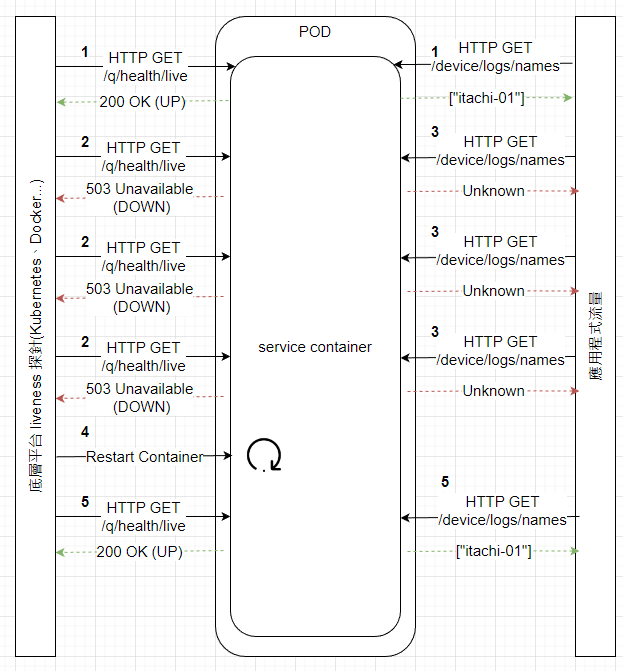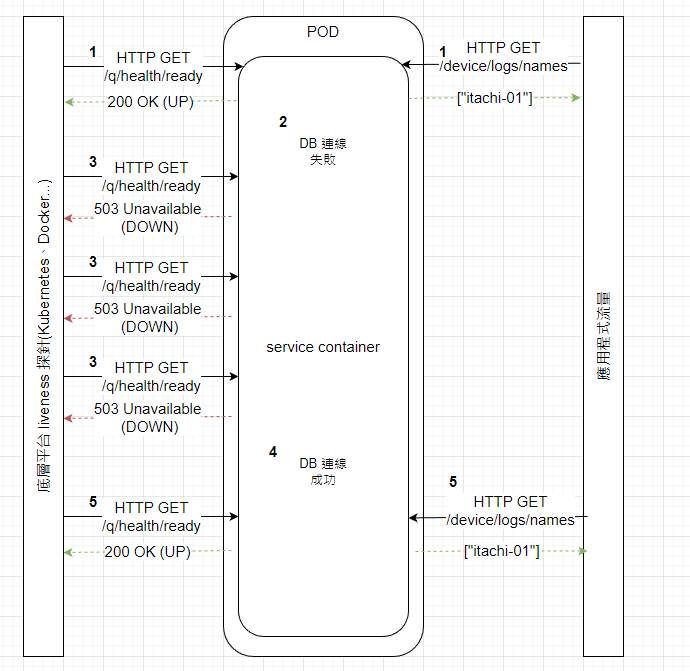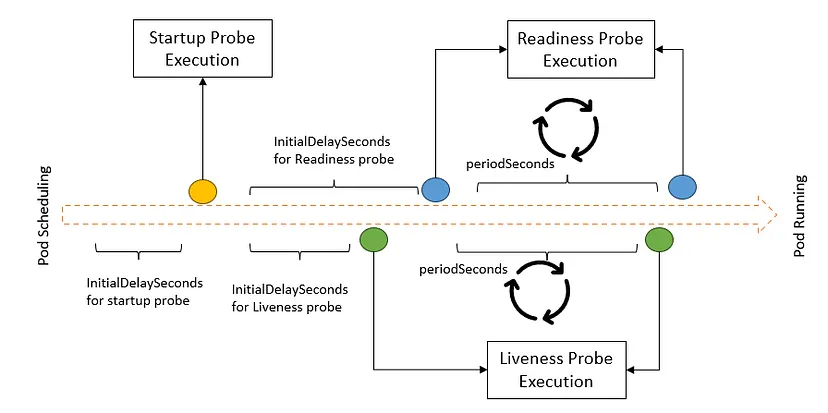本次學習目標
我們在 Quarkus 中新增以下依賴,該依賴實作 MicroProfile Health。該依賴用於幫助應用程式實現健康檢查的端點。默認會註冊 liveness、readiness 等探針,服務啟動時都會返回 UP 狀態。
implementation 'io.quarkus:quarkus-smallrye-health'
預設提供端點路徑是以下,期會搭配 quarkus.smallrye-health.root-path 根路徑,預設是 health。更多的配置可以至官方。
| 探針 | 路徑 | 對應配置 |
|---|---|---|
| liveness | live | quarkus.smallrye-health.liveness-path |
| readiness | ready | quarkus.smallrye-health.readiness-path |
| startup | started | quarkus.smallrye-health.startup-path |
MicroProfile Health 規範透過以下定義來支援這種健康檢測的契約:
/health/live 和 /health/ready 端點的訪問/q/health/live 和 /q/health/ready 端點liveness 和 readiness
當引入該依賴後,運行專案。並透過 curl 嘗試獲取 liveness、ready 等。沒錯這樣你的健康檢查就完成了。
$ curl http://localhost:8080/q/health/live
{
"status": "UP",
"checks": [
]
}
$ curl http://localhost:8080/q/health/ready
{
"status": "UP",
"checks": [
]
}
$ curl http://localhost:8080/q/health/started
{
"status": "UP",
"checks": [
]
}
liveness
底層平台向 /q/health/live 端點發出 HTTP 請求,以確定是否應該重新啟動應用程式。
如果服務是啟動的,則返回 200 的結果 UP;如果無法上線,返回 503 的結果 DOWN;無法被計算健康檢查,返回 500。此探針,預設端點在 /q/health/live
readiness
底層平台向 /q/health/ready 端點發出 HTTP 請求,以確定應用程式是否準備好接受流量。
如果服務已經準備好處理請求,返回 200 UP。相較於 liveness 不同,因為他表示服務已經啟動,但可能還不能處理任何請求(資料庫在做初始變動)。如果服務還不能接受任何請求,則返回 503 DOWN。同樣的無法被系統識別,則返回 500。此探針,預設端點在 /q/health/ready
接著引入一個連線 PostgreSQL 和 mqtt 的依賴。嘗試透過 MQTT 發送訊息,並接收訊息最後儲存至資料庫。
implementation 'io.quarkus:quarkus-hibernate-orm-panache'
implementation 'io.quarkus:quarkus-jdbc-postgresql'
implementation 'io.quarkus:quarkus-messaging-mqtt'
依賴導入完成後再安裝 PostgreSQL 和 EMQX 環境,讓 Quarkus 來進行交互。
$ docker compose -f infra/docker-compose.yaml up -d
環境安裝完後,配置連線資訊,如果要操作記得 IP 需要換成自己的環境 IP。
# configure your datasource
quarkus.datasource.db-kind = postgresql
quarkus.datasource.username = itachi
quarkus.datasource.password = 123456
quarkus.datasource.jdbc.url = jdbc:postgresql://172.25.150.200:5432/itachi
# drop and create the database at startup (use `update` to only update the schema)
quarkus.hibernate-orm.database.generation = drop-and-create
mp.messaging.outgoing.deviceOut.type=smallrye-mqtt
mp.messaging.outgoing.deviceOut.host=172.25.150.200
mp.messaging.outgoing.deviceOut.port=1883
mp.messaging.outgoing.deviceOut.auto-generated-client-id=true
mp.messaging.outgoing.deviceOut.qos=1
mp.messaging.outgoing.deviceOut.topic=test/device
mp.messaging.incoming.deviceIn.type=smallrye-mqtt
mp.messaging.incoming.deviceIn.host=172.25.150.200
mp.messaging.incoming.deviceIn.port=1883
mp.messaging.incoming.deviceIn.auto-generated-client-id=true
mp.messaging.incoming.deviceIn.qos=1
mp.messaging.incoming.deviceIn.topic=test/device
producer.generate.duration=1
當以上都完成後,運行 Quarkus 吧! 結果如下,沒錯最後 Quarkus 框架還是幫你弄好了,將會自動註冊一個 readiness 健康檢查,在 check 部分,以驗證是否能連接資料庫。而 MQTT 的探針分別針對 deviceIn 和 deviceOut Topic。
$ curl http://localhost:8080/q/health/live
{
"status": "UP",
"checks": [
{
"name": "SmallRye Reactive Messaging - liveness check",
"status": "UP",
"data": {
"deviceIn": "[OK]",
"deviceOut": "[OK]"
}
}
]
}
$ curl http://localhost:8080/q/health/ready
{
"status": "UP",
"checks": [
{
"name": "Database connections health check",
"status": "UP",
"data": {
"<default>": "UP"
}
},
{
"name": "SmallRye Reactive Messaging - readiness check",
"status": "UP",
"data": {
"deviceIn": "[OK]",
"deviceOut": "[OK]"
}
}
]
}
$ curl http://localhost:8080/q/health/started
{
"status": "UP",
"checks": [
{
"name": "SmallRye Reactive Messaging - startup check",
"status": "UP",
"data": {
"deviceIn": "[OK]",
"deviceOut": "[OK]"
}
}
]
}
假設服務需要與第三方進行交互,那也是可以自訂義端點。如下,分別定義 liveness 和 readiness。
@ApplicationScoped
@Liveness
public class LivenessProbe implements HealthCheck {
@Override
public HealthCheckResponse call() {
return HealthCheckResponse
.named("Custom Liveness Prob")
.withData("time", String.valueOf(new Date()))
.up()
.build();
}
}
以 liveness 來說,在 Quarkus 註冊流程如下。
HealthCheck 必須是 CDI bean,它使用 @ApplicationScoped 進行註釋,創建了一個CDI bean 實例
使用 @Liveness 表示它是一個 liveness 的健康檢查
實作 HealthCheck 介面,並覆寫 call() 方法
只要調用 /q/health/live 端點,就會調用 call() 方法,並返回一個 HealthCheckResponse 物件
每個健康檢查都有一個名稱(named),其反映健康檢查的意圖
上下文數據可以以鍵值對的形式添加到健康檢查中。(withData)
狀態始終返回 UP(up())
readiness
自訂義針對外部服務進行探針,相反的使用 @Readiness 註解實作,下面是針對外部服務進行實作。這邊定義了一個 externalURL 環境變數,用於讓探針針對該變數進行週期性的戳動作。其使用 HTTP GET 方式且狀態是 200 就表示成功。
@ConfigMapping(prefix = "health")
public interface HealthCheckConfig {
Readiness readiness();
interface Readiness {
String externalURL();
}
}
@ApplicationScoped
public class ReadinessProbe {
@Inject
HealthCheckConfig healthCheckConfig;
@Readiness
HealthCheck checkURL() {
return new UrlHealthCheck(healthCheckConfig.readiness().externalURL())
.name("ExternalURL health check").requestMethod(HttpMethod.GET).statusCode(200);
}
}
定義完後,可以如下看到定義的 ExternalURL health check。
$ curl http://localhost:8080/q/health/ready
{
"status": "UP",
"checks": [
{
"name": "ExternalURL health check",
"status": "UP",
"data": {
"host": "GET https://www.fruityvice.com/api/fruit/banana"
}
},
{
"name": "Database connections health check",
"status": "UP",
"data": {
"<default>": "UP"
}
},
{
"name": "SmallRye Reactive Messaging - readiness check",
"status": "UP",
"data": {
"deviceIn": "[OK]",
"deviceOut": "[OK]"
}
}
]
}
以上透過 Quarkus 輕鬆地透過框架配置了健康檢查部分。如果使用 Quarkus Kubernetes 依賴,生成 Kubernetes YAML 時,會在 Pod 層級資源中自動配置 liveness 和 readiness 等探針,其預設值不會特別去異動,就相信專業。接著將其部署至 Kubernetes 上。產生的 Deployment 如下
apiVersion: apps/v1
kind: Deployment
metadata:
annotations:
app.quarkus.io/quarkus-version: 3.13.3
app.quarkus.io/build-timestamp: 2024-08-27 - 14:38:39 +0000
labels:
app.kubernetes.io/name: app-health
app.kubernetes.io/version: 1.0.0-SNAPSHOT
app.kubernetes.io/managed-by: quarkus
name: app-health
spec:
replicas: 1
selector:
matchLabels:
app.kubernetes.io/name: app-health
app.kubernetes.io/version: 1.0.0-SNAPSHOT
template:
metadata:
annotations:
app.quarkus.io/quarkus-version: 3.13.3
app.quarkus.io/build-timestamp: 2024-08-27 - 14:38:39 +0000
labels:
app.kubernetes.io/managed-by: quarkus
app.kubernetes.io/name: app-health
app.kubernetes.io/version: 1.0.0-SNAPSHOT
spec:
containers:
- env:
- name: KUBERNETES_NAMESPACE
valueFrom:
fieldRef:
fieldPath: metadata.namespace
image: registry.hub.docker.com/cch0124/app-health:1.0.0-SNAPSHOT
imagePullPolicy: Always
livenessProbe:
failureThreshold: 3
httpGet:
path: /q/health/live
port: 8080
scheme: HTTP
initialDelaySeconds: 5
periodSeconds: 10
successThreshold: 1
timeoutSeconds: 10
name: app-health
ports:
- containerPort: 8080
name: http
protocol: TCP
readinessProbe:
failureThreshold: 3
httpGet:
path: /q/health/ready
port: 8080
scheme: HTTP
initialDelaySeconds: 5
periodSeconds: 10
successThreshold: 1
timeoutSeconds: 10
startupProbe:
failureThreshold: 3
httpGet:
path: /q/health/started
port: 8080
scheme: HTTP
initialDelaySeconds: 5
periodSeconds: 10
successThreshold: 1
timeoutSeconds: 10
下表整理上述所提的內容。
| Health check endpoints | HTTP status | JSON payload status |
|---|---|---|
| /q/health/live and /q/health/ready | 200 | UP |
| /q/health/live and /q/health/ready | 503 | DOWN |
| /q/health/live and /q/health/ready | 500 | Undetermined * |
從本範例中我們可以大致如下圖模擬 liveness 檢查流程

liveness 檢查和應用程式接收流量正程執行liveness 檢查失敗從本範例中我們可以大致如下圖模擬 readiness 檢查流程

readiness 檢查和應用程式接收流量正程執行readiness 檢查失敗,因為 DB 無法正常連線嘗試將 EMQX 服務停止。
docker stop emqx
此時去看 Pod 狀態,發現 Ready 變 False,且是 Readiness 探針是 503 屬於非成功。因此會不斷的嘗試
$ kubectl describe pods app-health-7bc94b5cdf-zlqwk
Name: app-health-7bc94b5cdf-zlqwk
Namespace: default
Priority: 0
...
Conditions:
Type Status
Initialized True
Ready False
ContainersReady False
PodScheduled True
Events:
Type Reason Age From Message
---- ------ ---- ---- -------
Normal Scheduled 56m default-scheduler Successfully assigned default/app-health-7bc94b5cdf-zlqwk to k3d-ithome-lab-cluster-agent-1
Normal Pulling 56m kubelet Pulling image "registry.hub.docker.com/cch0124/app-health:1.0.0-SNAPSHOT"
Normal Pulled 56m kubelet Successfully pulled image "registry.hub.docker.com/cch0124/app-health:1.0.0-SNAPSHOT" in 7.466872458s (7.466893449s including waiting)
Normal Created 56m kubelet Created container app-health
Normal Started 56m kubelet Started container app-health
Warning Unhealthy 5s (x21 over 3m5s) kubelet Readiness probe failed: HTTP probe failed with statuscode: 503
且 Service 對應的 Endpoints 會將 Pod 地址移除,如下。其最短移除時間可以這樣計算 (failureThreshold - 1) * periodSeconds + timeoutSeconds。
$ kubectl get endpoints
NAME ENDPOINTS AGE
...
app-health 80m
如果將 emqx 給啟用則 Service 將其 Pod 位置加入至 Endpoints 資源上。
$ kubectl get endpoints -w
NAME ENDPOINTS AGE
app-health 10.42.1.13:8080 113m
kubectl get pods -w -owide
NAME READY STATUS RESTARTS AGE IP NODE NOMINATED NODE READINESS GATES
app-health-7bc94b5cdf-zlqwk 1/1 Running 0 114m 10.42.1.13 k3d-ithome-lab-cluster-agent-1 <none> <none>
可以從上面結果得到以下結論:
/q/health/ready 端點的 HTTP 狀態碼來判斷如果將 liveness 探針的目標端點指向為存在的路徑,其會被 kubelet 殺掉並重啟,如下。重啟時間週期是
第一次探針:失敗(因為 /q/health/live 不存在)
第二次探針:失敗(因為 /q/health/live 不存在)
第三次探針:失敗(因為 /q/health/live 不存在)
由於每次探針的間隔是 10 秒,加上有 3 次失敗機會(failureThreshold)。所以最短在 30 秒後(10 秒 * 2 + 10 秒),Kubernetes 就會判定 Pod 不健康,並觸發重啟,計算上是 (failureThreshold - 1) * periodSeconds + timeoutSeconds。
$ kubectl get pods -o wide -w
app-health-7bc94b5cdf-zlqwk 0/1 Running 0 127m 10.42.1.13 k3d-ithome-lab-cluster-agent-1 <none> <none>
app-health-6496d8dbc4-qgcdn 0/1 Running 2 (21s ago) 29s 10.42.0.9 k3d-ithome-lab-cluster-agent-0 <none> <none>
app-health-6496d8dbc4-qgcdn 0/1 Running 2 (22s ago) 30s 10.42.0.9 k3d-ithome-lab-cluster-agent-0 <none> <none>
app-health-7bc94b5cdf-zlqwk 1/1 Running 0 127m 10.42.1.13 k3d-ithome-lab-cluster-agent-1 <none> <none>
app-health-6496d8dbc4-qgcdn 1/1 Running 2 (24s ago) 32s 10.42.0.9 k3d-ithome-lab-cluster-agent-0 <none> <none>
app-health-7bc94b5cdf-zlqwk 1/1 Terminating 0 127m 10.42.1.13 k3d-ithome-lab-cluster-agent-1 <none> <none>
app-health-7bc94b5cdf-zlqwk 0/1 Terminating 0 127m <none> k3d-ithome-lab-cluster-agent-1 <none> <none>
app-health-7bc94b5cdf-zlqwk 0/1 Terminating 0 127m 10.42.1.13 k3d-ithome-lab-cluster-agent-1 <none> <none>
app-health-7bc94b5cdf-zlqwk 0/1 Terminating 0 127m 10.42.1.13 k3d-ithome-lab-cluster-agent-1 <none> <none>
app-health-7bc94b5cdf-zlqwk 0/1 Terminating 0 127m 10.42.1.13 k3d-ithome-lab-cluster-agent-1 <none> <none>
app-health-6496d8dbc4-qgcdn 0/1 Running 3 (2s ago) 63s 10.42.0.9 k3d-ithome-lab-cluster-agent-0 <none> <none>
app-health-6496d8dbc4-qgcdn 0/1 Running 3 (9s ago) 70s 10.42.0.9 k3d-ithome-lab-cluster-agent-0 <none> <none>
app-health-6496d8dbc4-qgcdn 1/1 Running 3 (11s ago) 72s 10.42.0.9 k3d-ithome-lab-cluster-agent-0 <none> <none>
app-health-6496d8dbc4-qgcdn 0/1 Running 4 (2s ago) 103s 10.42.0.9 k3d-ithome-lab-cluster-agent-0 <none> <none>
app-health-6496d8dbc4-qgcdn 0/1 Running 4 (9s ago) 110s 10.42.0.9 k3d-ithome-lab-cluster-agent-0 <none> <none>
app-health-6496d8dbc4-qgcdn 1/1 Running 4 (11s ago) 112s 10.42.0.9 k3d-ithome-lab-cluster-agent-0 <none> <none>
從 events 可以清楚知道原因其其顯示在 Message 欄位,這對於除錯無可厚非是個好資源。
$ kubectl get events --sort-by='.lastTimestamp'
LAST SEEN TYPE REASON OBJECT MESSAGE
7m46s Normal Scheduled pod/app-health-6496d8dbc4-qgcdn Successfully assigned default/app-health-6496d8dbc4-qgcdn to k3d-ithome-lab-cluster-agent-0
11m Warning Unhealthy pod/app-health-7bc94b5cdf-zlqwk Readiness probe failed: HTTP probe failed with statuscode: 503
7m47s Normal ScalingReplicaSet deployment/app-health Scaled up replica set app-health-6496d8dbc4 to 1
7m47s Normal SuccessfulCreate replicaset/app-health-6496d8dbc4 Created pod: app-health-6496d8dbc4-qgcdn
7m41s Normal Pulled pod/app-health-6496d8dbc4-qgcdn Successfully pulled image "registry.hub.docker.com/cch0124/app-health:1.0.0-SNAPSHOT" in 5.506520701s (5.506540622s including waiting)
7m39s Normal Pulled pod/app-health-6496d8dbc4-qgcdn Successfully pulled image "registry.hub.docker.com/cch0124/app-health:1.0.0-SNAPSHOT" in 1.49692412s (1.49693049s including waiting)
7m23s Normal Pulled pod/app-health-6496d8dbc4-qgcdn Successfully pulled image "registry.hub.docker.com/cch0124/app-health:1.0.0-SNAPSHOT" in 1.619209349s (1.619233429s including waiting)
7m15s Normal SuccessfulDelete replicaset/app-health-7bc94b5cdf Deleted pod: app-health-7bc94b5cdf-zlqwk
7m15s Normal ScalingReplicaSet deployment/app-health Scaled down replica set app-health-7bc94b5cdf to 0 from 1
6m47s Warning Unhealthy pod/app-health-6496d8dbc4-qgcdn Liveness probe failed: HTTP probe failed with statuscode: 404
6m47s Normal Killing pod/app-health-6496d8dbc4-qgcdn Container app-health failed liveness probe, will be restarted
6m47s Warning Unhealthy pod/app-health-6496d8dbc4-qgcdn Readiness probe failed: Get "http://10.42.0.9:8080/q/health/ready": EOF
6m46s Normal Pulling pod/app-health-6496d8dbc4-qgcdn Pulling image "registry.hub.docker.com/cch0124/app-health:1.0.0-SNAPSHOT"
6m44s Normal Pulled pod/app-health-6496d8dbc4-qgcdn Successfully pulled image "registry.hub.docker.com/cch0124/app-health:1.0.0-SNAPSHOT" in 1.530334886s (1.530354226s including waiting)
6m44s Normal Created pod/app-health-6496d8dbc4-qgcdn Created container app-health
6m44s Normal Started pod/app-health-6496d8dbc4-qgcdn Started container app-health
2m40s Warning BackOff pod/app-health-6496d8dbc4-qgcdn Back-off restarting failed container app-health in pod app-health-6496d8dbc4-qgcdn_default(cc9614a0-0583-40b0-9d3b-85e944c47172)
liveness 探針觀察到的行為是
若整題來看,檢康檢查可以帶來以下優勢
下圖為探針的執行順序,執行完 startupProbe 後就會往後交給 liveness 和 readiness 執行。

From https://blog.devgenius.io/k8s-for-de-probes-b598a1adeecf

 iThome鐵人賽
iThome鐵人賽
 看影片追技術
看更多
看影片追技術
看更多